6.1 Triglycerides and Fatty Acids
Triglyceride
Triglycerides make up more than 95 percent of lipids in the diet and are also the main form of lipid found in the body. Fatty acids and glycerol are the building blocks of triglycerides. Glycerol is a three-carbon molecule that is often used in the food industry. Glycerol is not a lipid but it forms the backbone of triglycerides by bonding with three fatty acids. Triglycerides contain varying mixtures of fatty acids. Figure 6.2 shows the chemical structure of a triglyceride.
Figure 6.2 Chemical Structure of a Triglyceride
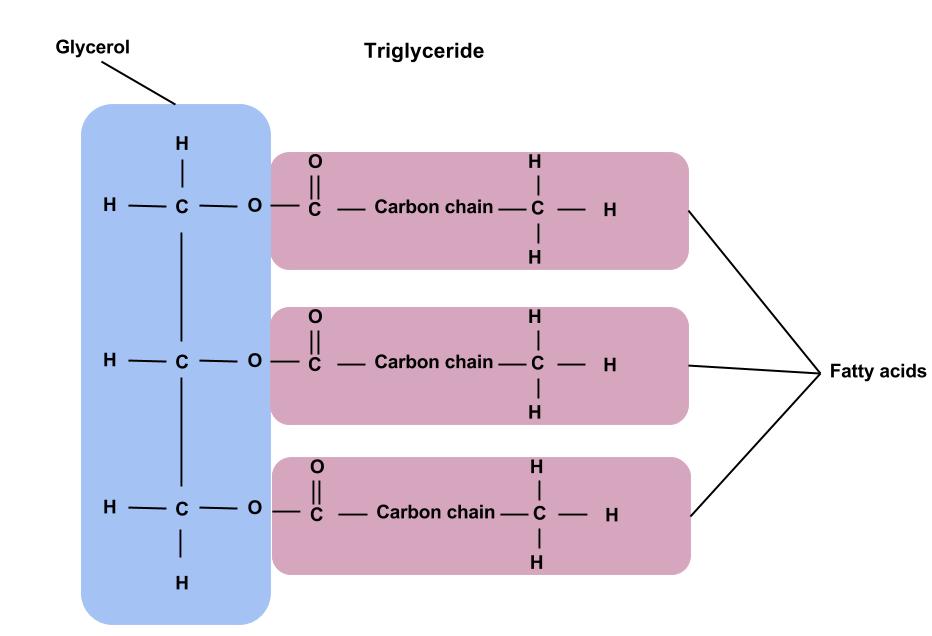
Fatty Acids
Fatty acids are the building blocks of triglycerides and phospholipids. Figure 6.3 shows the chemical structures of fatty acids. Fatty acids are hydrocarbon chains (chains of carbon with hydrogen attached) with a carboxylic acid (−COOH) group on one end of the hydrocarbon chain and a methyl group (−CH3) on the other end.
Figure 6.3 Chemical Structure of a Fatty Acid
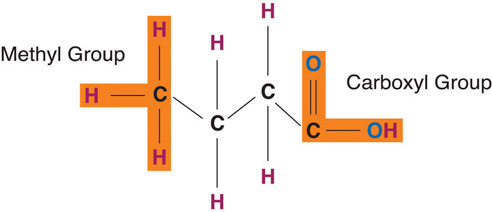
Fatty acids can differ from one another in two important ways – carbon chain length and degree of saturation. When categorizing fatty acids, the first thing we will look at is the degree of saturation. Figure 6.4 shows the difference between a saturated fatty acid (the hydrocarbon chain is completely saturated with hydrogens) and an unsaturated fatty acid (the hydrocarbon chain has one or more double bonds or points of unsaturation). Saturated and unsaturated fatty acids are discussed in more detail later in this chapter.
Figure 6.4 Chemical Structures of Saturated vs Unsaturated Fatty Acids
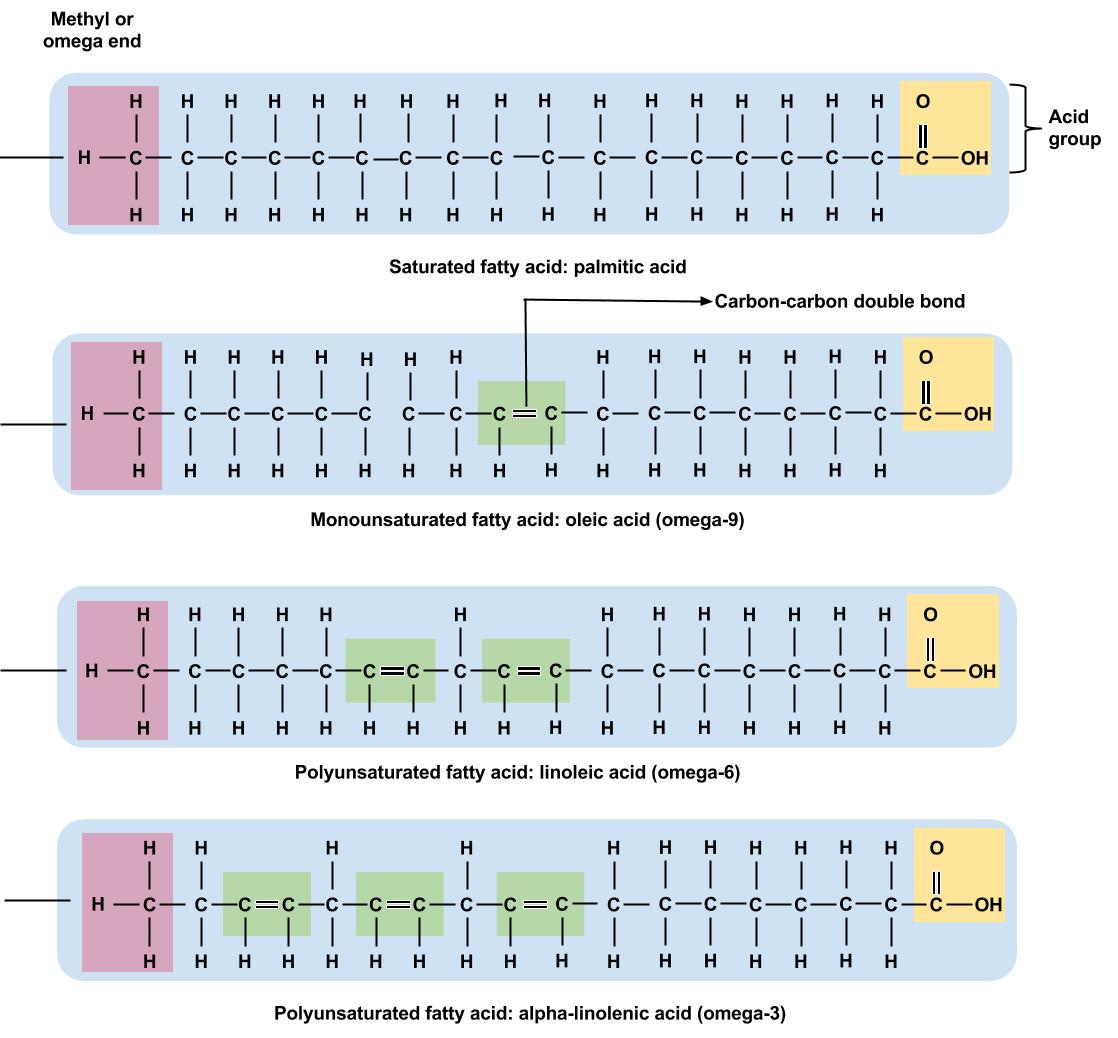
Fatty acids have different chain lengths and different compositions. Foods have fatty acids with chain lengths between four and twenty-four carbons and most of them contain an even number of carbon atoms. When the carbon chain length is shorter, the melting point of the fatty acid becomes lower – and the fatty acid becomes more liquid.
In the following sections, you will learn about different types of fatty acids and food sources. However, keep in mind that most foods will contain a combination of many different types of fatty acids. The following sections will categorize foods based on the predominant type of fatty acid.
Figure 6.5 Fat Content of Various Foods
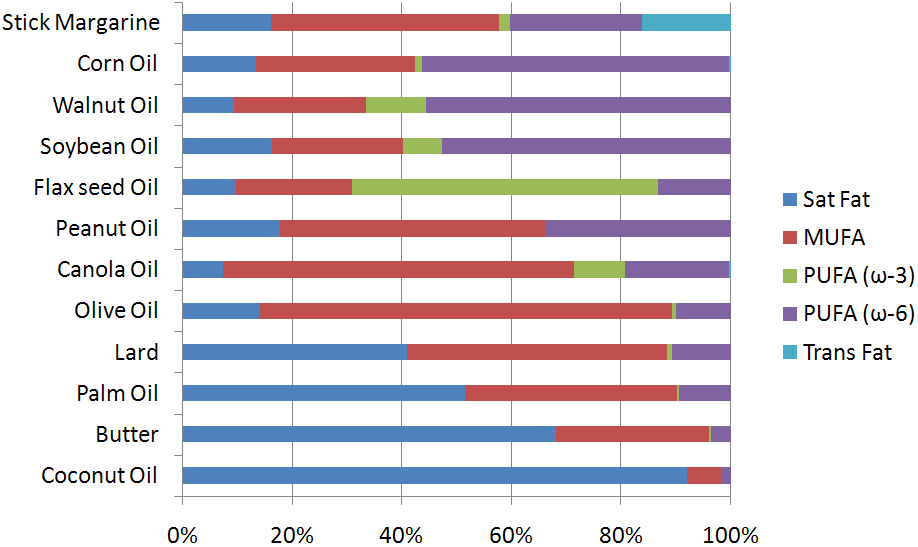
Fat Content of Various Foods
Saturated Fatty Acids
The term saturated means filled to capacity; for example, a saturated sponge cannot hold more water. In relation to fatty acids, fatty acid chains are held together by carbon atoms that attach to each other and to hydrogen atoms. The term saturation refers to whether or not a fatty acid chain is filled (or “saturated”) to capacity with hydrogen atoms. If each available carbon bond holds a hydrogen atom we call this a saturated fatty acid chain. All carbon atoms in such a fatty acid chain are bonded with single bonds. When the overall molecule is seen, the entire fatty acid appears as a fairly straight line. In this orientation many saturated fatty acids may line up side by side, similar to soldiers standing at attention. This formation causes saturated fatty acids to pack together very tightly which is why they are solid at room temperature. Think of a stick of butter or a jar of coconut oil at room temperature. Other foods that are relatively high in saturated fatty acids include red meats (beef, pork), dairy products (milk, yogurt, cheese, ice cream, butter) and tropical oils (cocoa, palm oil, coconut oil). These tropical oils are the only plant based foods that contain high amounts of saturated fats. Saturated fatty acids have been associated with elevated blood cholesterol levels and increased inflammation which may increase risk of heart disease and stroke. Most foods do contain a combination of saturated and unsaturated fatty acids.
Unsaturated Fatty Acids
Sometimes the carbon chain has a place where hydrogen atoms are missing. This is referred to as the point of unsaturation. When one or more bonds between carbon atoms are a double bond (C=C), that fatty acid is called an unsaturated fatty acid, as it has one or more points of unsaturation. When this occurs, the linear orientation of the overall molecule is bent, or kinked, as the double-bond pulls differently between the atoms involved. These bends prevent neighboring fatty acids from forming the tight, side-by-side grouping that is seen in saturated fatty acids. Because they are spaced apart, these fatty acids form liquid fats, typically called oils, at room temperature. Unsaturated fatty acids have been associated with reduced blood cholesterol levels and inflammation which may reduce risk of heart disease and stroke.
Monounsaturated fatty acids
Any fatty acid that has only one double bond in the carbon chain is a monounsaturated fatty acid. Some examples of foods high in monounsaturated fatty acids include peanuts and peanut butter, olives and olive oil, avocados and avocado oil. Even though poultry such as chicken and turkey are often considered lean meats and low in fat, the fatty acids found in poultry are mostly monounsaturated. Monounsaturated fats help regulate blood cholesterol levels, thereby reducing the risk for heart disease and stroke.
Polyunsaturated Fatty Acids
A polyunsaturated fatty acid is a fatty acid with two or more double bonds or two or more points of unsaturation. Vegetable oils (safflower oil, corn oil, soybean oil), products made with vegetable oils (mayonnaise), whole grains, nuts, and seafood are considered sources of polyunsaturated fatty acids. Polyunsaturated fatty acids also help regulate blood cholesterol levels and reduce risk of heart disease and stroke. Figure 6.6 reviews the types of fatty acids we have covered so far.
Figure 6.6 Comparison of Saturated, Monounsaturated, and Polyunsaturated Fatty Acids
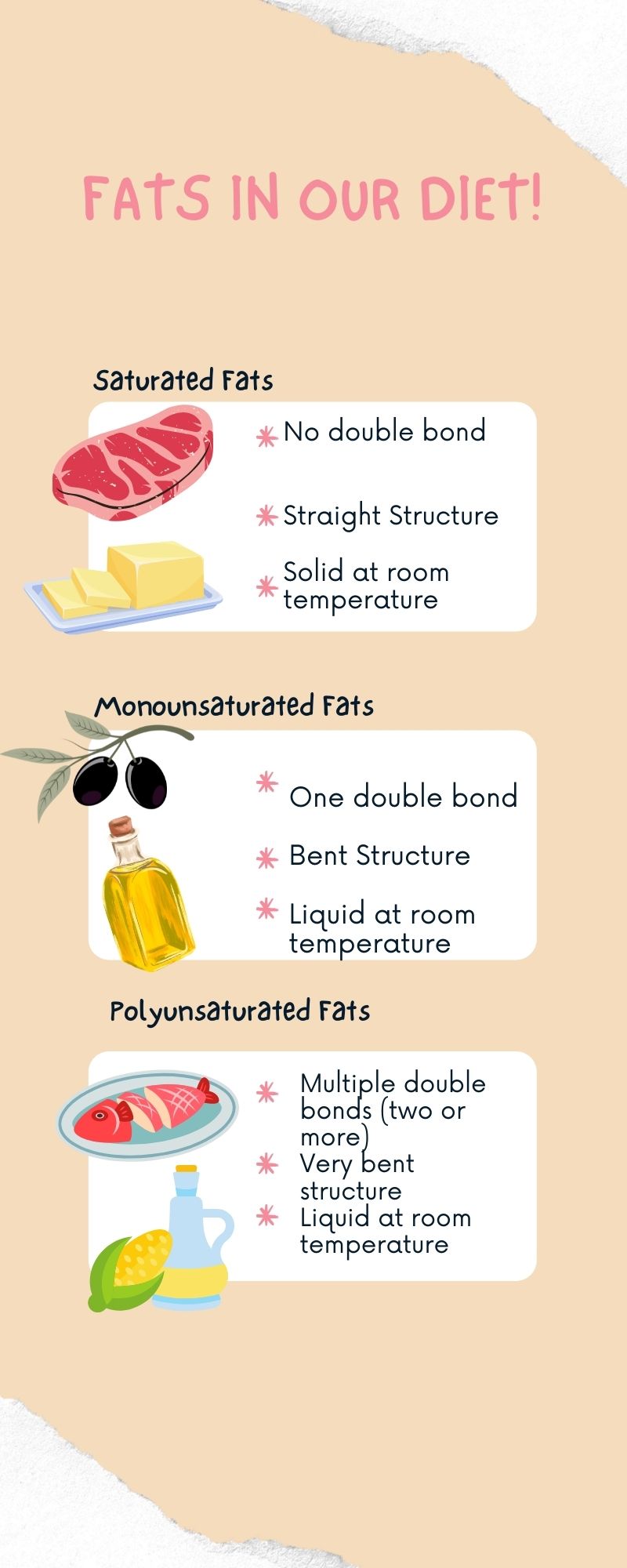
Essential Fatty Acids
There are two essential fatty acids that the human body cannot synthesize: linoleic acid (omega-6) and alpha-linolenic (omega-3). Both omega 3 and omega 6 are a type of polyunsaturated fatty acid. The 3 and 6 refer to the position of the first carbon double bond and the omega refers to the methyl end of the chain. Omega-3 and omega-6 fatty acids are precursors to important compounds called eicosanoids. Eicosanoids are powerful hormones that control many other hormones and important body functions, such as the central nervous system and the immune system. Eicosanoids derived from omega-6 fatty acids are known to increase blood pressure, immune response, and inflammation. In contrast, eicosanoids derived from omega-3 fatty acids are known to reduce blood pressure, immune response, and inflammation. Given the contrasting effects of the omega-3 and omega-6 fatty acids, a proper dietary balance between the two must be achieved to ensure optimal health benefits.
Dietary sources of linoleic acid (omega 6) include most vegetable oils, most nuts, and whole grains. After digestion and absorption, linoleic acid is converted into arachidonic acid which is converted into eicosanoids that increase blood pressure, immune response, and inflammation.
Dietary sources of alpha-linolenic acid (omega 3) include certain oils, nuts, and seeds. Flax seeds, walnuts, chia seeds, canola oil, and soy are considered high in alpha-linolenic acid. After digestion and absorption, alpha-linolenic acid is converted into docosahexaenoic acid (DHA) and eicosapentaenoic acid (EPA) which in turn are converted into eicosanoids that reduce blood pressure, immune response, and inflammation. However, the conversion of alpha-linolenic acid to DHA and EPA is very inefficient. Less than 10% of the alpha-linolenic acid that you consume will be converted into DHA and EPA. There is one good dietary source of DHA and EPA though, seafood. There is DHA and EPA in all fish and shellfish, however there is more DHA and EPA in fatty fish like salmon. The best way to make sure your omega 3 needs are being met is to consume 2 servings of fish or seafood a week. If you google “sources of omega 3” you will likely see lists that contain meat, eggs, or dairy products. The actual amount of omega 3 found in these foods depends on the diet of the animal that produced them. Most animals raised for commercial purposes are not fed diets high in omega 3 so there is not a significant amount of omega 3 in most meat, eggs, or dairy. If the animals were grass fed then there may be some omega 3 – but it still depends on the nutrient content of the grass. In short, unless your eggs are labeled omega 3 fortified, they are probably not a significant source of omega 3.
Figure 6.7 Dietary Sources of Omega 3 Fatty Acids
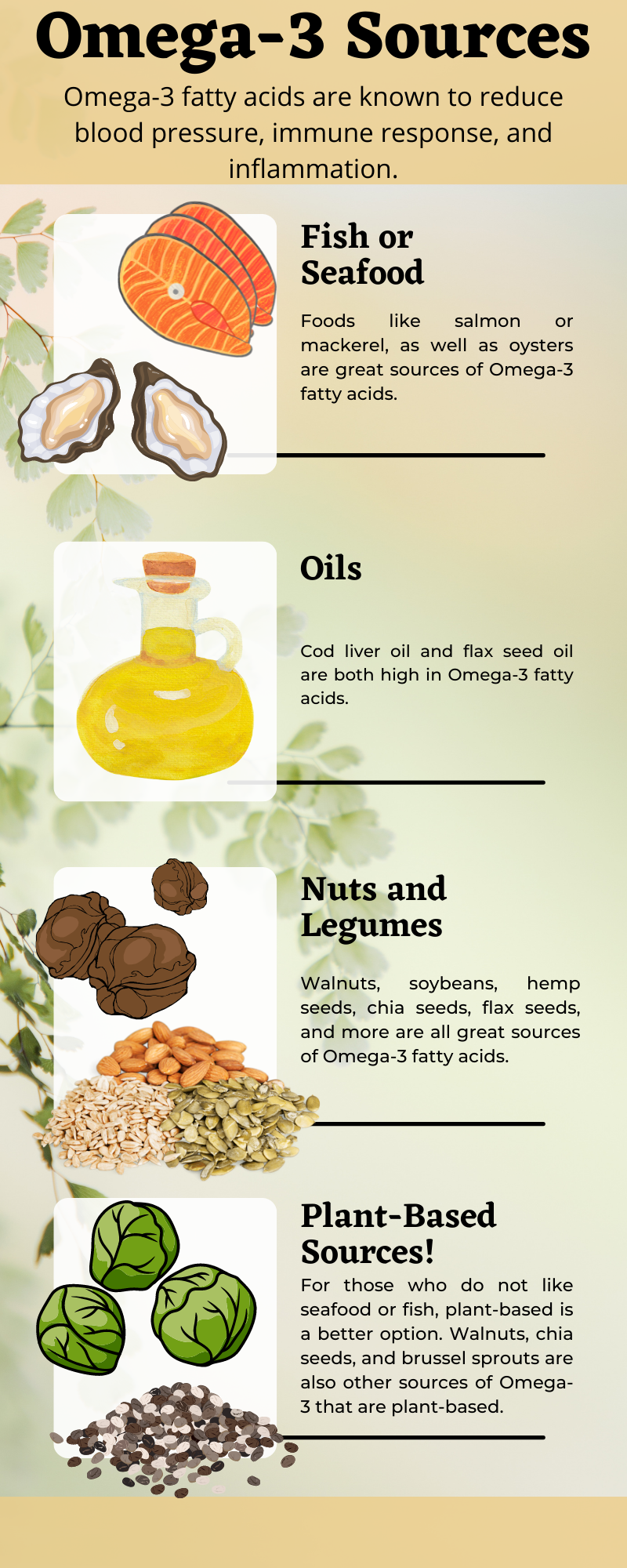
If you don’t like fish, you can meet your omega 3 needs through alpha-linolenic acid. Two servings of alpha-linolenic acid per day is recommended to meet your omega 3 needs. Supplements can also be used to meet omega 3 needs. Fish oil is a popular omega 3 supplement but you can also get omega 3 from flax oil or algae supplements. Just remember that dietary supplements are not carefully regulated in the US so you need to do your research on the brand you choose to consume. If they are third party certified, that ensures the purity of the product but you still want to be careful not to overdose. More is not always better and mega doses of DHA and EPA supplements have been linked to excessive bleeding and increased risk of hemorrhage.
Essential fatty acids play an important role in the life and death of cardiac cells, immune system function, and blood pressure regulation. Docosahexaenoic acid (DHA) is an omega-3 essential fatty acid shown to play important roles in synaptic transmission in the brain during fetal development.
As our food choices evolve, the sources of omega-6 fatty acids in typical American diets are increasing at a much faster rate than sources of omega-3 fatty acids. Omega-3s are plentiful in diets of non-processed foods where grazing animals and foraging chickens roam free, eating grass, clover, alfalfa, and grass-dwelling insects. In contrast, today’s western diets are bombarded with sources of omega-6. For example, we have oils derived from seeds and nuts and from the meat of animals that are fed grain. Vegetable oils used in fast-food preparations, most snack-foods, cookies, crackers, and sweet treats are also loaded with omega-6 fatty acids. Also, our bodies synthesize eicosanoids from omega-6 fatty acids and these tend to increase inflammation, blood clotting, and cell proliferation, while the hormones synthesized from omega-3 fatty acids have just the opposite effect.
While omega-6 fatty acids are essential, they can be harmful when they are out of balance with omega-3 fatty acids. Omega-6 fats are required only in small quantities. Researchers believe that when omega-6 fats are out of balance with omega-3 fats in the diet they diminish the effects of omega-3 fats and their benefits. This imbalance may elevate the risks for allergies, arthritis, asthma, coronary heart disease, diabetes, and many types of cancer, autoimmunity, and neurodegenerative diseases, all of which are believed to originate from some form of inflammation in the body.
Trans Fatty Acids
The introduction of a carbon-carbon double bond in a hydrocarbon chain, as in an unsaturated fatty acid, can result in different structures for the same fatty acid composition. When the hydrogen atoms are bonded to the same side of the carbon chain, it is called a cis fatty acid. Because the hydrogen atoms are on the same side, the carbon chain has a bent structure. Naturally occurring fatty acids usually have a cis configuration.
In a trans fatty acid, the hydrogen atoms are attached on opposite sides of the carbon chain. Unlike cis fatty acids, most trans fatty acids are not found naturally in foods, but are a result of a process called hydrogenation. Hydrogenation is the process of adding hydrogen to the carbon double bonds, thus making the fatty acid saturated (or less unsaturated, in the case of partial hydrogenation). This is how vegetable oils are converted into semisolid fats for use in the manufacturing process.
Figure 6.8 Chemical Structure of Saturated, Unsaturated in Cis Formation and Unsaturated in Trans Formation Fatty Acids
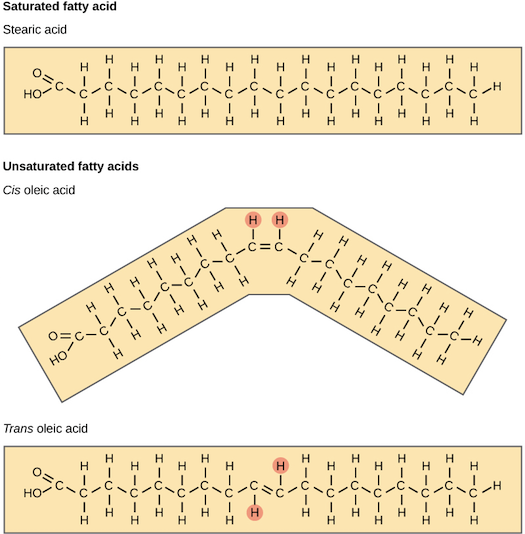
Processing naturally occurring fats to modify their texture from liquid to semisolid and solid forms results in the development of trans fats, which have been linked to an increased risk for heart disease. Trans fats are used in many processed foods such as cookies, cakes, chips, doughnuts, and snack foods to give them their crispy texture and increased shelf life. You can see that trans fatty acids are unsaturated fatty acids with chemical structures that resemble saturated fatty acids. Therefore, trans fatty acids behave like saturated fatty acids in your body. Trans fatty acids have been shown to increase blood cholesterol levels and inflammation like saturated fatty acids. However, trans fatty acids are more potent than saturated fats. In 2015, the FDA determined that partially hydrogenated oils (PHOs), the primary source of dietary trans fats, were no longer generally recognized as safe. Since then, steps have been made to remove PHOs from the food supply. As of January 1, 2020, manufacturers cannot add PHOs to foods sold in the US. However, there are some exceptions to these rules and products that are still working their way through distribution so you may still find fully or partially hydrogenated oils in foods sold in stores. The best way to minimize your trans fat intake is to check the ingredients list for any kind of hydrogenated oil. When selecting your foods, steer clear of anything that says “hydrogenated,” “fractionally hydrogenated,” or “partially hydrogenated,” and read food labels in the following categories carefully:
- cookies, crackers, cakes, muffins, pie crusts, pizza dough, and breads
- stick margarines and vegetable shortening
- premixed cake mixes, pancake mixes, and drink mixes
- fried foods and hard taco shells
- snack foods (such as chips), candy, and frozen dinners
Choose brands that don’t use trans fats and that are low in saturated fats.
Lipid Recommendations for Athletes
Athletes need fats, especially unsaturated fats, in their diet. However, athletes generally have higher carbohydrate and protein requirements than the general population, therefore, their fat intakes often fall on the lower end of the general recommendations provided in the Dietary Guidelines for Americans. Severe fat restrictions are not recommended because it can have a detrimental effect on health and performance. Fat is required to create sex-related hormones and to absorb fat-soluble vitamins, both of which are important for athletes. Severe restriction of fat can also lead to deficiencies in the essential fatty acids, omega 3 and omega 6.
Instead of focusing on restricting fat, athletes should focus on consuming enough high quality fats such as unsaturated and omega 3 fats. College athletes are at risk of overconsuming fat and not getting enough carbohydrate and protein due to a reliance on convenience and fast foods. Focusing on whole, unprocessed foods, choosing lower fat cuts of meat or dairy products, and increasing plant (fruits, vegetables, whole grains) is a good first step for many athletes in training and also follows general nutrition guidelines.
Media Attributions
- Structure of a Triglyceride © Allison Calabrese is licensed under a CC BY (Attribution) license
- Structure of a Fatty Acid © Allison Calabrese is licensed under a CC BY (Attribution) license
- Types of Fatty Acids © Allison Calabrese is licensed under a CC BY (Attribution) license
- Fat Content of Various Foods © Pierce College is licensed under a CC BY (Attribution) license
- Fats in our Diet! © Natalie Fox is licensed under a CC BY (Attribution) license
- Omega-3-Sources © Natalie Fox is licensed under a CC BY (Attribution) license
- Chemical Structures of saturated, cis-unsaturated, and trans-unsaturated fatty acids © OpenStax Biology is licensed under a CC BY (Attribution) license
